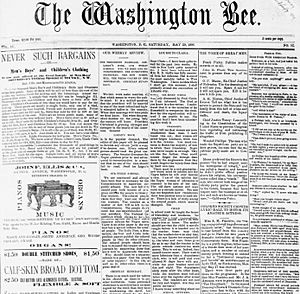Washington Bee facts for kids

The Washington Bee – May 29, 1886
|
|
| Type | Weekly newspaper |
|---|---|
| Format | Broadsheet |
| Owner(s) | Bee Publishing Company |
| Publisher | Bee Publishing Company |
| Founded | June 3, 1882 |
| Language | American English |
| Ceased publication | January 21, 1922 |
| Headquarters | 1109 I Street, NW Washington, D.C. 20005 |
| Country | United States |
| ISSN | 1940-7424 |
| OCLC number | 10587828 |
The Washington Bee was a weekly newspaper published in Washington, D.C. It started in 1882 and was mainly read by African American people. For almost all of its 40 years, the newspaper was led by William Calvin Chase. He was an African American lawyer and journalist. The Bee supported the Republican Party. It was published, with a few breaks, until 1922. This was shortly after its editor, William Calvin Chase, passed away.
Contents
History of The Washington Bee Newspaper
Starting as a Weekly Paper (1882–1922)
The Washington Bee was published during a time when African Americans faced many challenges. It was hard for them to have a strong voice in politics. People like editor William Calvin Chase had to work very hard to keep the progress made in earlier years.
At first, Chase's newspaper criticized some African American leaders. These leaders believed in finding ways to get along with the difficult social rules of the time. But later, Chase and the Bee became more friendly with influential leaders like Booker T. Washington. The Bee also had a rival newspaper in Washington, D.C., called the Colored American.
The Bee's main slogan was "Sting for Our Enemies – Honey for Our Friends." The Library of Congress says that the Bee showed the Republican views of its editor. However, Chase was not afraid to criticize Republican leaders if he thought they were wrong.
We don't know exactly how many copies of the Bee were sold. But the highest number mentioned was 9,700 in 1922. That same year, the Bee stopped publishing because it could not continue after its editor died in 1921.
How the Paper Looked and Its Price
The Washington Bee was a large newspaper called a broadsheet. This was a common size for newspapers back then. An issue from May 1886 shows how the weekly paper usually looked.
About two columns on the front page were used for ads. These ads were for businesses and also for smaller classified ads. The other four columns had short updates about news stories. It was assumed that people who bought the paper already knew the main details of these stories. In May 1886, a single copy of the Bee cost five cents. A yearly subscription was $2.00.
The Bee accepted ads that reflected the social customs of its time. This included ads for housing that was separate for different groups of people. For example, an ad from June 1893 offered:
The first opportunity offered colored people to secure Homes on Weekly payments of 50 cents a week or Two Dollars per month – 1000 Lots For Sale – In the city of Bowie, State of Maryland. Only 20 minutes ride from Washington. Double track. 22 trains stop daily. Fare to and from Washington, only Six cents by commutation ticket.
The Bee's Influence Across the Country
Even though African American residents in Washington, D.C., did not have a formal vote in national matters, Chase and the Bee could still speak out. The Library of Congress believes the Bee was "one of the most influential African American newspapers in the country."
The Bee used its influence through carefully written articles. For example, in March 1912, the newspaper celebrated the appointment of Mahlon Pitney to the Supreme Court of the United States. The Bee wrote that Pitney was a good choice. It also highlighted how people's protests helped stop another judge, William Cather Hook, from getting the job. Hook had a record that was not supported by many, including African Americans. This showed how powerful people's voices could be when they spoke up.
What the Paper Covered
The Washington Bee covered a variety of news stories and events.
Where to Find Old Issues Today
The Library of Congress has saved many issues of the Bee. You can find them from August 2, 1884, until the paper stopped publishing in 1922. Another place to find old issues is the Genealogy bank.

